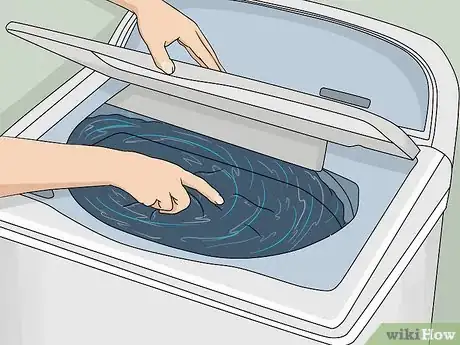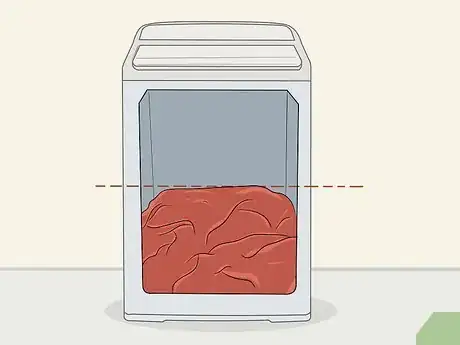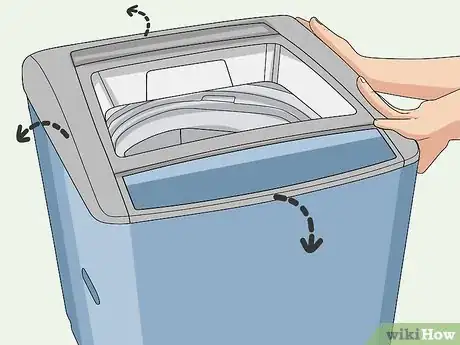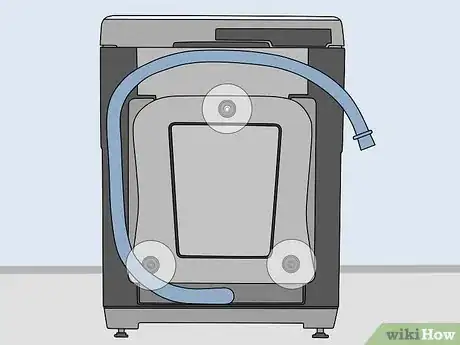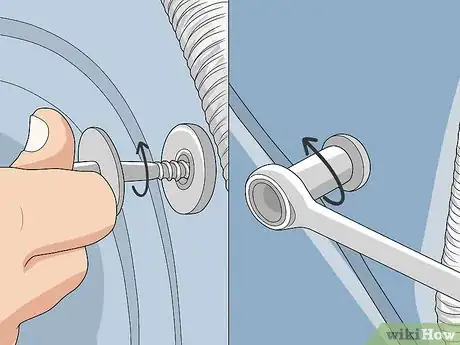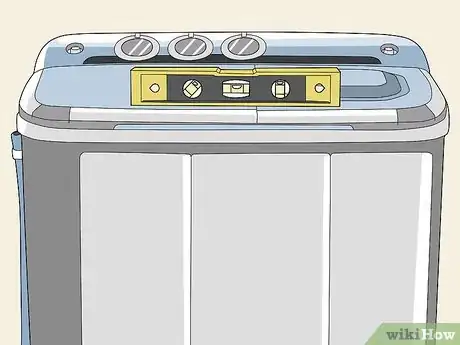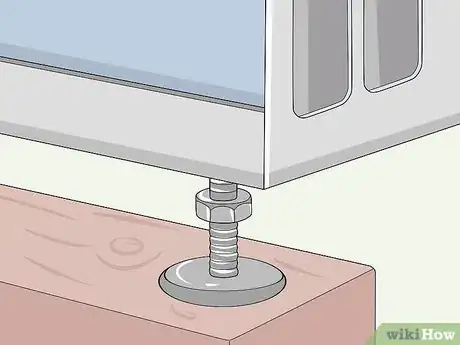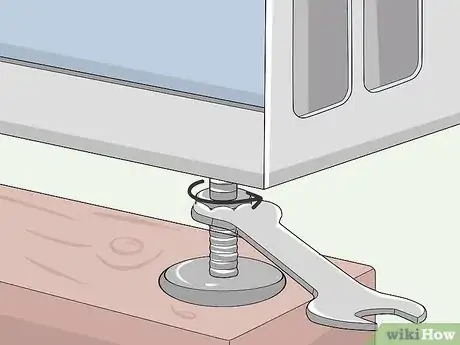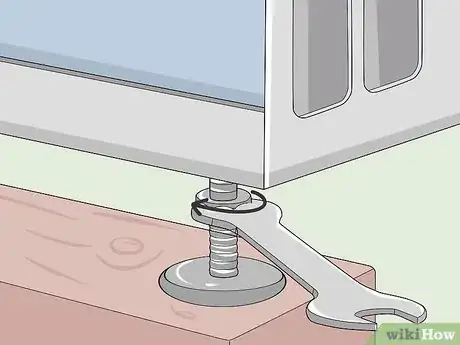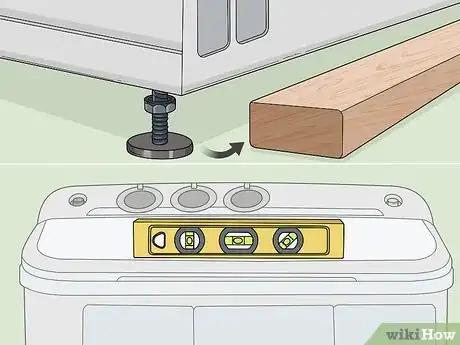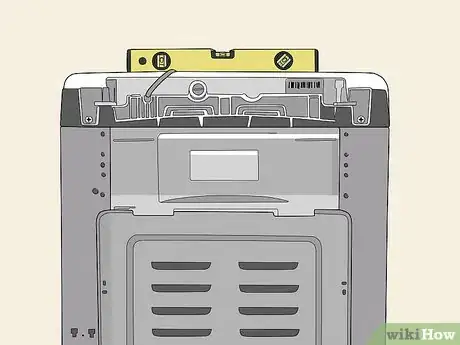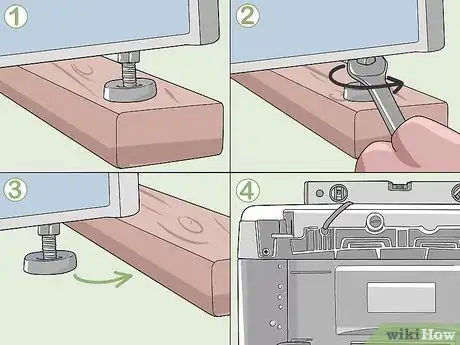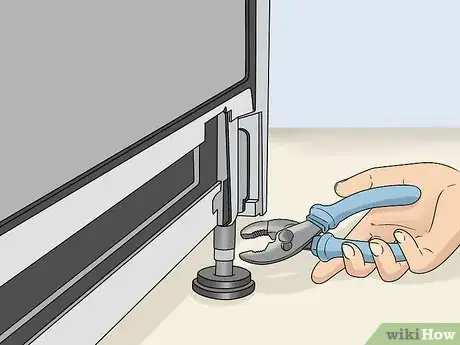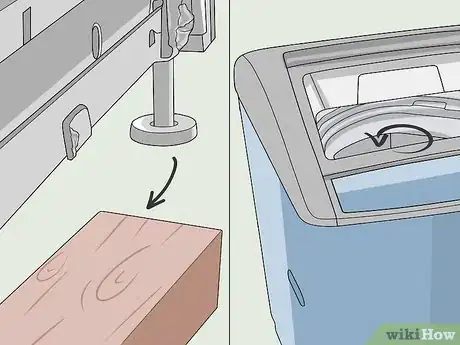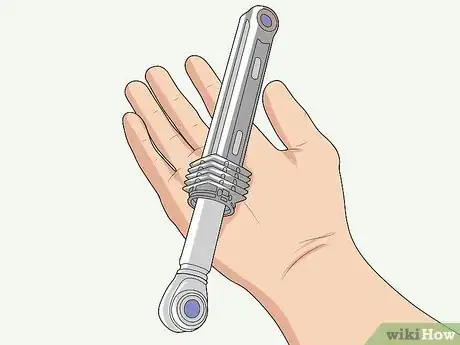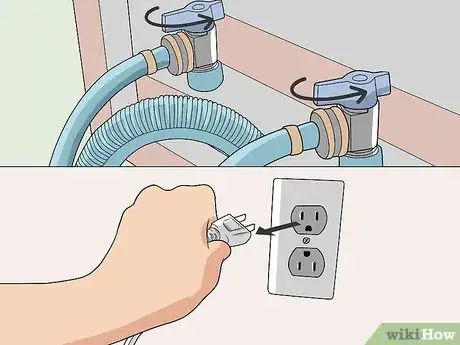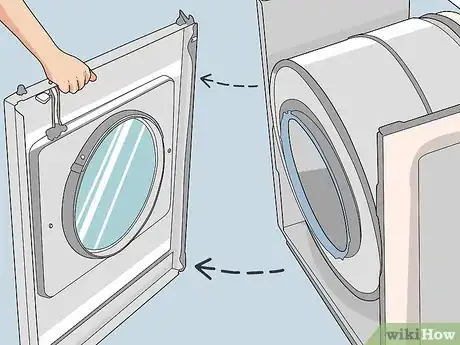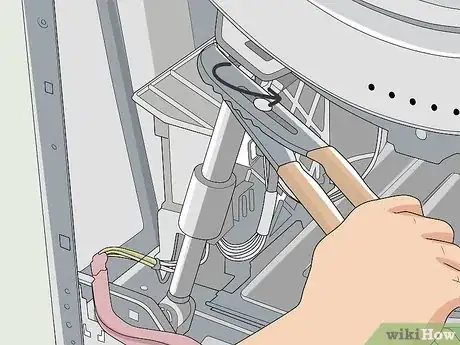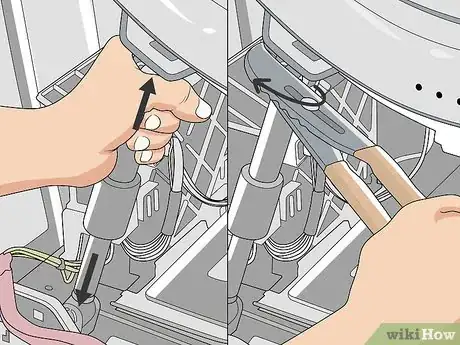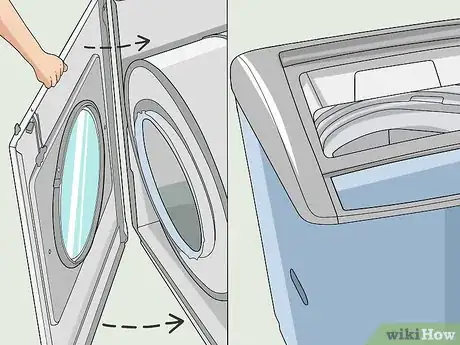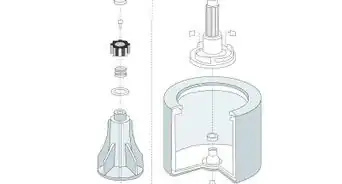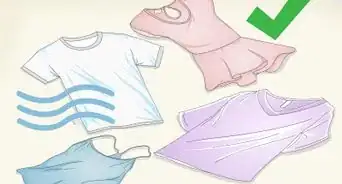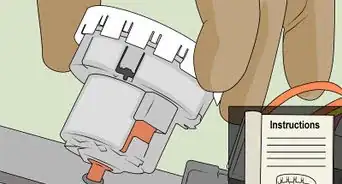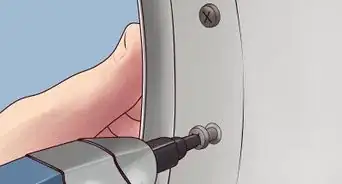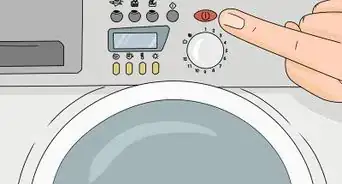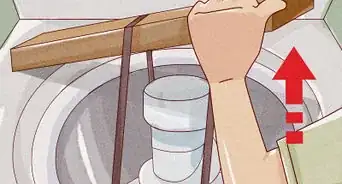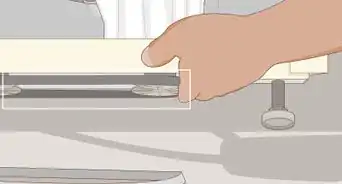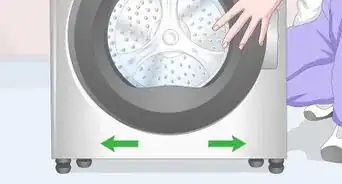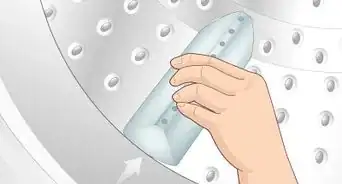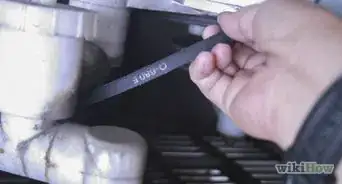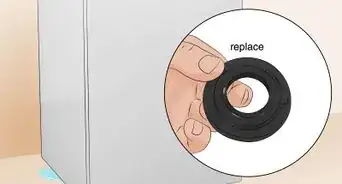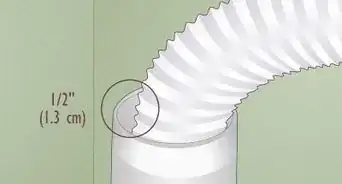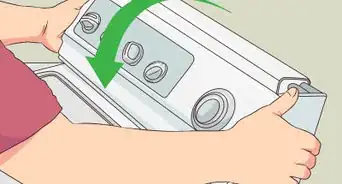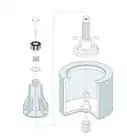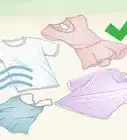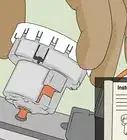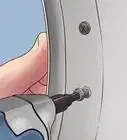This article was co-authored by Egor Shevtsov and by wikiHow staff writer, Eric McClure. Egor Shevtsov is a Home Improvement Specialist and Managing Partner at Appliance Techie in Orange County, California. With over seven years of experience, he specializes in maintaining and repairing appliances. He earned a Bachelor of Arts in Business Administration and Management from the International American University and a Master of Business Administration from the Russian University of Cooperation, former Moscow University of Consumer Cooperation.
This article has been viewed 751,363 times.
A shaking washing machine can be quite concerning. It may feel like the floor is about to collapse underneath your machine, and the sound can make it seem like the entire building is falling apart. Fear not! The odds are high that your clothes aren’t evenly distributed inside your drum. Outside of an improperly-loaded machine, the most common source of a shaking washer is that the legs are not level, which is an incredibly easy fix. If it won’t stop shaking after you’ve leveled it, you may want to replace the shock absorbers, which can be a tougher fix for a non-professional. If you ever run into a problem that you can’t solve, consult a repair company to see if they can solve the issue.
Steps
Performing Quick Fixes
-
1Move your clothes around in the middle of a spin cycle. If your washer starts shaking during the spin cycle, pause the washing machine. Open the door to inspect the arrangement of your clothes. If there is an uneven pile, your drum may have simply bundled your clothes into an uneven ball. Spread your clothes out and resume your spin cycle.[1]
- Washing machines often shake because the mass of clothes is distributed unevenly inside of them. Always make sure to spread out the clothes throughout your washer as you load it.
- If your washer continues to shake, remove some of your clothes. You may have simply overloaded it.
- If your washer consistently causes your clothes to bundle together into an uneven ball, the drum is probably absorbing weight unevenly because it isn’t level.
-
2Use smaller loads of clothes when filling your washing machine. You may be filling the drum with too many clothes when you use your washer, even if it doesn’t seem like it. Only add clothes until the drum is half-full so that the clothes have room to move when the drum spins. For a front-loading machine, pile your clothes up higher towards the back of the drum and avoid leaving them near the door. Front-loading machines have a tougher time distributing clothes evenly as the drum spins.
- Top-loading machines can typically handle more clothing. If you’re in the market for a new washer, opt for a top-loading machine if you can.
- Overfilling your machine will also keep your clothes from getting adequately clean.
Advertisement -
3Try rocking the machine when it isn’t running to see if it tilts and move it. To see if your washer isn’t level, put both hands on the top of your washer. Try pushing it side-to-side. If it wobbles or gives at all, your machine isn’t level and the vibration from the drum is making the legs bang repeatedly into the floor. Find a more even section of flooring and move the washer to see if the problem stops.[2]
- If your dryer is unlevel too, then it’s probably your floor’s fault. Try finding a flatter area of your home to set the machines or slide a sheet of plywood underneath them.
-
4Look for shipping bolts on the back and bottom of a new washer. Open a front-loading washer and try to press the bottom of the drum down. If it doesn’t move at all, the delivery or installation crew probably forgot to remove the shipping bolts. Turn your washer on to its side. Look underneath the machine and behind it for plastic clamps that are shoved over the openings or bolts.
- The shipping bolts ensure that your drum doesn’t move during delivery and installation. They will cause a machine to shake if they’re left in.
- Depending on the make and model of your machine, the shipping bolts may be hiding behind the back panel. If your back panel simply slides out, lift it up to see if there are any plastic pieces latched to your drum.
-
5Remove the shipping bolts by hand or with a wrench. Remove the shipping bolts by squeezing the handle and pulling them. If the bolts are screwed into a panel, place a wrench over the bolt and turn it counterclockwise to loosen and remove them. Sometimes, you can simply unscrew the bolts by hand.[3]
- The shipping bolts are usually brightly-colored so that they’re easy to notice. They also tend to be made from a cheap plastic. They should look really out of place on your machine.
Leveling a Washer
-
1Place a spirit level on top of your washer near the front. Take a spirit level and place it on the top of your washing machine along the front end. Check to see which side is tilting up by looking at the bubble in the middle of your level. The side that the bubble is leaning towards is higher than the other side.[4]
- It is better to raise a leg than lower one, so adjust the leg that is too high.
- Newer machines typically don’t have adjustable legs in the back.
-
2Lift the washer and put a block of wood under the bottom of the front. Shut the water lines and turn the electricity off by unplugging your machine. Pull your machine 2–3 feet (0.61–0.91 m) away from any walls. Tilt the machine so that the front legs lift off of the floor and the slide a block of wood under the front of the machine. Let your machine back down slowly so that it rests on the block.[5]
- If your machine isn’t stable as it rests on the block, add another block next to your first block to distribute the weight more evenly.
- You can use a brick or other solid object if you don’t have a block of wood.
-
3Turn the bolts on the legs with a wrench to adjust the front legs. Start by adjusting the leg that is higher. Use a wrench or channel locks to loosen the bolt on the top of the leg by turning it counterclockwise. Then, turn the base of the leg clockwise to raise it by twisting it.[6]
-
4Tighten the bolt above the base of the leg to lock it in place. Use channel locks or a wrench to turn the bolt near the top of the leg clockwise. Turn it until it is tight against the base of your machine. This will lock the leg and keep it from moving when you lower it.[7]
- Some newer machines don’t use a locking bolt. You simply adjust the leg by turning it and you don’t need to worry about locking it.
- You can use trial and error by lowering the legs and checking the level again, or your can try to measure each leg with a measuring tape. You may not be able to visually determine if the legs are even.
-
5Lower your washing machine and check the spirit level again. Slide the wood block out and slowly lower the machine back down. Put your level back on top of your machine and check the air bubble to see if it is level. If it is, try wobbling your machine again. If it doesn’t move, you’ve successfully leveled the machine. If it wobbles and the front is level, you have to adjust the legs in the back.[8]
- Use a levelling tool so you'll be able to set the washer straight on each side.
-
6Place the level on the control panel at the back to check the back legs. Most modern washing machines have self-leveling legs in the back and you won’t need to adjust them. If your machine is more than 10 years old though, this may not be the case. Place your level flat on top of the control panel near the back of the machine. If the bubble is centered, your back legs do not need to be readjusted.[9]
- If the back legs are level, tap each leg in the back 2-3 times with your wrench or channel locks. There may be a little rust or dirt stuck in the self-leveling joint.
- If your control panel is round on top or set at an angle, place your level directly in front of it.
-
7Use the same process you used with the front legs to adjust the back legs. Use the level to determine which leg is higher. Lift the machine up a little bit and slide a piece of wood underneath. Adjust the higher leg in the back to make it lower using the same bolt and tools that you used on the front.[10]
-
8Tap the self-leveling support if the rear legs aren’t adjustable. If you tilt your machine and discover that your back legs are indeed self-adjusting, lint and rust may have built up on the rear legs to keep them from moving. Tap the exposed legs lightly with the back of your wrench or channel locks to shake the rust and dirt off.[11]
- You can also spray the legs with a little bit of machine or hinge lubricant. Wipe off the excess lubricant after you’ve applied it to the leg near the connection to the frame.
-
9Lower the machine and try running an empty cycle. Remove the wooden block and lower your machine back down. Slide the machine back into place and run the machine while it’s empty. If the machine doesn’t shake, you’ve successfully levelled it. If it continues to shake, you probably need to replace the shock absorbers.[12]
Replacing the Shock Absorbers
-
1Order replacement shock absorbers from your machine’s manufacturer. Use the model number and brand listed on your machine to determine what kind of washing machine you’re using. Contact your manufacturer and order some replacement shock absorbers.
- The shock absorbers are small coils or pistons that absorb the vibration from your drum when it’s spinning. They also connect the drum to the frame of the machine. There are either 2, 4, or 5 of them depending on your model.
- The model and brand are usually listed on the front, but they may be printed on a metal plate on the back of the machine or inside of the door.
- Some newer models require a professional to install new shock absorbers. Read your machine’s manual to see if you can take the front panel off to access the shock absorbers.
-
2Disconnect the water and turn off the electricity. Find the supply lines for cold and hot water on the back of your machine. Twist the valve on each line so that it is closed. Turn the electricity for your machine off by unplugging it.
- The water lines are usually thin and made of rubber. They often have a blue and red valve on top of them near the connection to the frame.
-
3Remove the front panel for a front-load washer. Ask your manufacturer or consult your machine’s manual to determine how to remove your front panel. Usually this involves removing the rubber seal around your drum and unscrewing several screws under the panel before lifting it up.[13]
- If your remove the bottom panel on a top-load washer and see a spring rolling around, your suspension rod fell off. Hook it back into the center of your drum and put the machine back. This was causing the noise and shaking.
- Remove the bottom panel on a top-load washer. You’ll have to tilt the machine on its side to do this. Keep the case from getting scratched by laying a rug or towel out before doing this.
-
4Unscrew the shock absorbers with a wrench or channel locks. Find the shock absorbers by looking for rods connecting the drum to the frame. Unscrew the bolts connecting each rod to the drum and frame. Remove your rods and set them aside. They may not appear to be broken, but the inner coil in one of these absorbers may be broken.
- Some shock absorbers have pins locking them to the drum and the frame. If any of the pins fell out, simply slide them back in. This was probably the cause of your shaking.
- If you have 5 absorbers, 1 of them is probably in the back. You may not be able to reach this piece without professional assistance.
-
5Insert your new shock absorbers and tighten them. Put your replacement parts in the corresponding locations. Screw each one into place by tightening the bolt after you’ve slid it on to the threading. Tighten the bolts with your wrench or channel locks by turning each one clockwise until it won’t turn anymore.
-
6Reinstall the panels and run a test wash. Put your panel back and screw in the corresponding screws. Put the rubber seal back and open your water lines. Plug the machine in and set it to run a basic wash cycle. If you hear rattling inside the machine, you probably missed a bolt for a shock absorber. If the machine still wobbles but doesn’t rattle, you probably need to replace the drum.
- Replacing the drum in a washing machine is often not worth it, and you should consult a washing machine repair company to determine the price of the repair. It is not typically a problem that a non-professional can solve.
Community Q&A
-
QuestionWhat should I do if my front-loading washing machine is stuck in the rinse cycle?
 wikiHow Staff EditorThis answer was written by one of our trained team of researchers who validated it for accuracy and comprehensiveness.
wikiHow Staff EditorThis answer was written by one of our trained team of researchers who validated it for accuracy and comprehensiveness.
Staff Answer wikiHow Staff EditorStaff AnswerThe rinse cycle is the point in a wash where the machine utilizes cold water. If your machine keeps running on the rinse cycle, it's a sign that your cold water connection is clogged and your machine keeps running while it tries to pull in enough water. Close the connection on the water supply line by turning the valve and remove the line to see if it's damaged or clogged. Either replace the line or remove the blockage to see if that solves your problem.
wikiHow Staff EditorStaff AnswerThe rinse cycle is the point in a wash where the machine utilizes cold water. If your machine keeps running on the rinse cycle, it's a sign that your cold water connection is clogged and your machine keeps running while it tries to pull in enough water. Close the connection on the water supply line by turning the valve and remove the line to see if it's damaged or clogged. Either replace the line or remove the blockage to see if that solves your problem. -
QuestionWhy won't my washing machine spin?
 wikiHow Staff EditorThis answer was written by one of our trained team of researchers who validated it for accuracy and comprehensiveness.
wikiHow Staff EditorThis answer was written by one of our trained team of researchers who validated it for accuracy and comprehensiveness.
Staff Answer wikiHow Staff EditorStaff AnswerIs the electricity on? If it is, try adding fewer clothes per cycle. Some older machines have an overload function where the drum won't turn if there's too much weight inside. If you can't tell if the electricity is on, try flipping the breaker on your fuse box to see if the connection was bad.
wikiHow Staff EditorStaff AnswerIs the electricity on? If it is, try adding fewer clothes per cycle. Some older machines have an overload function where the drum won't turn if there's too much weight inside. If you can't tell if the electricity is on, try flipping the breaker on your fuse box to see if the connection was bad. -
QuestionIs there any other reason the washer would shake besides level?
 Community AnswerIt could be the suspension rods. Replacing them is doable. Pull up a video on YouTube for your make/model.
Community AnswerIt could be the suspension rods. Replacing them is doable. Pull up a video on YouTube for your make/model.
Things You’ll Need
Performing Quick Fixes
- Wrench
Levelling a Washer
- Spirit level
- Wood block
Replacing the Shock Absorbers
- Channel locks or wrench
- Replacement absorbers
References
- ↑ https://youtu.be/-hU4DwjpAMs?t=26
- ↑ https://www.familyhandyman.com/appliance-repair/washer-and-dryer-repair/stop-washing-machine-vibration/
- ↑ https://youtu.be/iXr5nVLcPH0?t=39
- ↑ https://www.familyhandyman.com/appliance-repair/washer-and-dryer-repair/stop-washing-machine-vibration/
- ↑ https://www.familyhandyman.com/appliance-repair/washer-and-dryer-repair/stop-washing-machine-vibration/
- ↑ https://www.familyhandyman.com/appliance-repair/washer-and-dryer-repair/stop-washing-machine-vibration/
- ↑ https://www.familyhandyman.com/appliance-repair/washer-and-dryer-repair/stop-washing-machine-vibration/
- ↑ https://www.familyhandyman.com/appliance-repair/washer-and-dryer-repair/stop-washing-machine-vibration/
- ↑ https://www.familyhandyman.com/appliance-repair/washer-and-dryer-repair/stop-washing-machine-vibration/
- ↑ https://www.familyhandyman.com/appliance-repair/washer-and-dryer-repair/stop-washing-machine-vibration/
- ↑ https://www.familyhandyman.com/appliance-repair/washer-and-dryer-repair/stop-washing-machine-vibration/
- ↑ https://www.familyhandyman.com/appliance-repair/washer-and-dryer-repair/stop-washing-machine-vibration/
- ↑ https://youtu.be/zLZA4Z2vKqk?t=16
About This Article
To fix a shaking washing machine, pause the spin cycle and redistribute the clothes so they’re more balanced. Washing smaller loads can also help prevent imbalances. When the machine isn’t running, try rocking it to see if it’s unstable. You might need to move it to a more level area. If that doesn’t work, check the back of the washer to make sure the shipping bolts were removed when your washer was installed, since they can prevent the basin from spinning properly. If the shipping bolts are still in place, remove them by hand or using a wrench. To learn more about replacing shock absorbers, read on!
